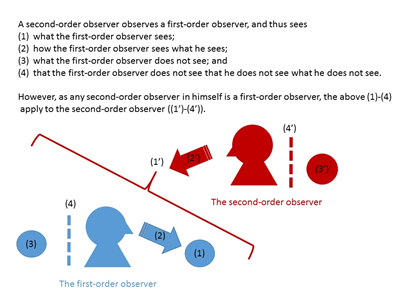LC 00488: verschil tussen versies
Geen bewerkingssamenvatting |
Geen bewerkingssamenvatting |
||
| Regel 12: | Regel 12: | ||
{{Include lesson learned|Lesson learned=LL 00022|Description=Stakeholders' worldviews may differ.|Reference=LC 000346}} | {{Include lesson learned|Lesson learned=LL 00022|Description=Stakeholders' worldviews may differ.|Reference=LC 000346}} | ||
[[Bestand:First and second order observation.png|gecentreerd|miniatuur|403x403px|Figure: first and second order observation.]] | [[Bestand:First and second order observation.png|gecentreerd|miniatuur|403x403px|'''Figure:''' first and second order observation.]] | ||
When you look at an object in the outside world, you are a first-order observer. A second-order observer observes how a first-order observer observes the outside world. So, the focus of attention is switched to ''how'' one looks, instead of ''what'' one sees. This is an important shift because it opens the possibility to thoroughly think through questions like: why is someone doing or saying things the way he does or says? The answers can be found in observing the distinctions that are made by taking a seconder-order point of view. | When you look at an object in the outside world, you are a first-order observer. A second-order observer observes how a first-order observer observes the outside world. So, the focus of attention is switched to ''how'' one looks, instead of ''what'' one sees. This is an important shift because it opens the possibility to thoroughly think through questions like: why is someone doing or saying things the way he does or says? The answers can be found in observing the distinctions that are made by taking a seconder-order point of view. | ||
<accesscontrol>Access:We got to move</accesscontrol> | <accesscontrol>Access:We got to move</accesscontrol> | ||
Versie van 29 mei 2020 14:04
Laws of Form showed in a formal way that the observer and observed coincide. In particular, the mark of distinction (˥) established the relation between distinction and indication: there cannot be a distinction without indication, and the other way round. The distinction severs a space in a marked and a unmarked state. An observer can observe only the marked side of the distinction in the act of observing, the other side is his blind spot. So, everyone has blind spots, which you can put to the test by yourself by observing the Necker cube and the Rubin vase.
The cube can viewed from two perspectives, but not at the same time.
If you have trouble seeing both perspectives, then the dotted, hidden edges might help to discern them.
You see the vase or the two silhouettes, but again, not at the same time.
At any one time, one view is perceived, whereas the other view is currently in your blind spot. Not only in the moment you perceive you have a blind spot, the very way how you perceive have its (implicit) blind spots as well because of the distinctions you apply. You need someone else to point out your blind spots to you.
Geleerde les: Blind spots
Samenvatting:
You need someone else to point out your blind spots to you.
Context:
Stakeholders' worldviews may differ.
- Iedereen houdt zijn eigen wereldbeelden erop na, inclusief de (impliciete) blinde vlekken die dat met zich meebrengt.
- Wederzijds begrip is mogelijk als anderen mogen wijzen op jouw blinde vlekken;
- Reflecteer vanuit een tweede-orde observatie standpunt.
When you look at an object in the outside world, you are a first-order observer. A second-order observer observes how a first-order observer observes the outside world. So, the focus of attention is switched to how one looks, instead of what one sees. This is an important shift because it opens the possibility to thoroughly think through questions like: why is someone doing or saying things the way he does or says? The answers can be found in observing the distinctions that are made by taking a seconder-order point of view.
Dit is een beveiligde pagina.
- Lees hiervoor:
- Lees hierna:
Referenties
- Steps to an Ecology of Mind, Gregory Bateson, Jason Aronson Inc, 1 januari 1972.
- Objects as tokens for eigenbehaviours, H. von Foerster, Observing Systems, Systems Inquiry Series, pp. 274-285, 1 januari 1981.
- On the cybernetics of fixed points, Louis Kauffman, Cybernetics, 1 januari 2001.
- Processes and Boundaries of the Mind; Extending the Limit Line, Yair Neuman, Spriner Science Business Media, 1 januari 2003.
Hier wordt aan gewerkt of naar verwezen door: Gesprekken met betrokkenen voeren





